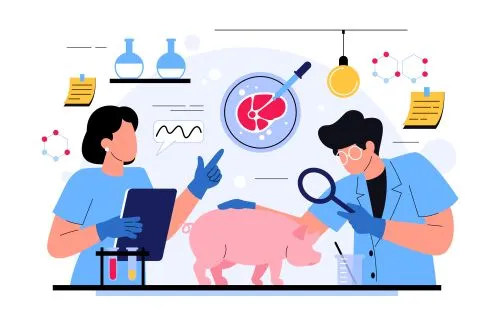1556

From "recycling spent hens" into flavor enhancers to recreating breast milk in a laboratory, FoodNavigator has presented five of the most innovative technologies of the year 2023.
A Year of Challenges
It has been a challenging year for the startup world, with thin investments in some areas. According to the innovation charity Nesta, venture capital investments in food industry startups reached a peak in 2021 but declined by more than half in 2022.
We still haven't seen startup valuations fully recover, but inflation is easing, and those with a half-full mindset will be optimistic for the future. As Martin Davos, a partner at the food technology and services investment firm McWin Partners, recently said, "The best companies are created in times of crisis. The best entrepreneurs are made in times of crisis."
Looking back at 2023, it's clear that challenging economic environments do not halt innovation. This year, we encountered a wide range of innovative startups in the food industry, and as we move into December, we thought it appropriate to gather five of the most innovative ones.
From a startup that recycles "spent hens" into flavor enhancers to another company that produces breast milk in a laboratory, here are five startups that caught our attention in 2023.
Vegbloc: Replacing, but not mimicking, meat
First up is Vegbloc, a UK-based startup that has not yet hit the market. What sets Vegbloc apart is not that it makes plant-based meat substitutes – we've seen that category become increasingly saturated – but that it approaches meat substitutes through a different lens.
Vegbloc is entirely uninterested in mimicking meat: the newcomer doesn't look, smell, or taste like the real thing, and it has no intention of doing so.
This means you won't find extruded pea or soy protein isolates on the ingredient list. Instead, the meat substitute is made from quinoa, red lentils, split peas, flaxseeds, onion, chia seeds, gram flour, rosemary, sweet potatoes, mushrooms, garlic, nutritional yeast, smoked paprika, salt, mushroom powder, coriander, and black pepper.
As a bonus, its carbon footprint is over 30 times smaller than that of beef.
"We're upfront about Vegbloc's ingredients and appeal to meat consumers who are skeptical of 'fake meats,' as well as vegans/vegetarians/flexitarians who would like a more convenient yet natural option," said co-founder Simon Day to FoodNavigator in June. (If Day's name sounds familiar, it's because he is also the founder of the Bread & Jam startup festival in London).
By veering away from meat mimicry, Day foresees the potential to attract consumers in the UK and even across Europe. The concept is already in the prototype stage, proving popular among consumers. "Once you've shed the straightjacket of mimicry, you can ditch highly processed and undesirable ingredients and are free to create truly nourishing products with their own delicious taste and texture...
"The first reaction is that this is something genuinely new and refreshing, that we've created something with its own texture and flavor, not trying to imitate meat!"
ÄIO: Turning sawdust into food
Estonian startup ÄIO began its life at Tallinn University of Technology, where Petri-Jaan Lahtvee and Nemailla Bonturi worked together to produce edible fats and oils from agricultural and woody sectors.
Now, nearing its two-year anniversary, ÄIO believes its solution can help provide alternatives to tropical oils and animal fats for multiple industries, including food.
Solid vegetable fats are currently used for various purposes, from formulating foods to cosmetics. However, palm, coconut, shea, and cocoa can only be grown in the tropics, posing environmental sustainability issues. According to ÄIO's founders, the solution is to use fermentation processes to provide new fats and oils that they claim are rich in fatty acids and antioxidants.
ÄIO uses a "red bungee" microbe – created and patented by Bonturi – that feeds on side streams from agriculture, the food industry, and wood, such as sawdust, lactose, and molasses. "In the same way we make kombucha, yogurt, bread, and beer, we can turn sawdust or other low-value biomass into valuable and healthy ingredients," said Bonturi. "'Our red bungee' can't turn water into wine, but it can turn sawdust into food."
Next, ÄIO aims to scale up production capacity, test products in cooperation with the food industry, and apply for new food permits to enter the European market. The startup hopes to start producing its fats and oils on an industrial scale by 2026.
This year, the startup raised one million euros from investors, including Nordic Foodtech VC and the Estonian Agency for Business Innovation.
Nūmi: Replacing infant formula with lab-cultivated breast milk
Just last month, we met with the co-founder of the French biotechnology startup Nūmi, Eden Banon, who, together with Eugenie Peze-Heidsieck, seeks to replace "inadequate" infant formulas.
The problem is that the vast majority of formulas on the market are made from cow's milk, with a small percentage from soy and rice. Whether made from cow's milk, cereals, or legumes, current offerings are not convenient, explained Banon.
"The complexity of breast milk meets all the developmental needs of babies, from brain and retina development to satiety regulators and strengthening the immune system. It is composed of over 1,500 constituents, and attempting to reproduce this from another species is suboptimal."
So, instead of sticking with the status quo of cow's milk-based formula, Nūmi turns to cell culture to reproduce human milk from mammary cells. Cell culture technology involves growing cells in controlled conditions, usually outside their natural environment. Nūmi recreates the environment of the mammary gland (the organ responsible for milk synthesis) for human cells to produce milk.
"We use several sources of efficient cell lines and cultivate them in controlled conditions," we were told. Specifically, the team isolates selected cells, cultivates them in controlled conditions, and feeds them nutrients to grow, duplicate, and produce human milk. The final step is purification, before being ready for human consumption.
"Cell culture technology allows you to replicate the entire lactation phenomenon in vivo, in vitro, using what nature does best – but now with the help of science."
Nūmi will need to apply for authorization before entering the market, and Banon expects to launch initially in the United States. "The U.S... is more welcoming to innovations in this field and has created a more defined regulatory landscape for innovations like ours, while Europe is still evolving.
"We hope very much that Europe will follow suit and that we will be able to bring our products to European and French families fairly soon."
Rice in Action: Healthier, more sustainable rice
Rice is a staple crop for over 3.5 billion people worldwide. Cultivated since 5000 BCE, innovation in rice – beyond plant breeding and genetic modifications to enhance sustainability credentials – is rare.
But in Spain, ancient cereals have been revitalized by the startup Rice in Action. Using its proprietary technology, Rice in Action has reduced the glycemic index of rice and cooking time, with benefits for health, sustainability, and productivity.
The startup claims that its rice can offer 12 times the productivity increase to food sector customers, while simultaneously reducing energy costs by 60 times.
Without delving too much into the patented technology, Rice in Action cold-infuses rice with broth, flavors, and nutrients in a "precise way." The rice can be reserved in just two to four minutes, without the need to add water or broth. "We've turned a universal and delicious ingredient – but one that is often complicated due to lack of cooking skills and a hectic lifestyle – into an ideal ingredient for quick cooking," said Christophe Pais, co-founder of the Madrid-based startup, to FoodNavigator earlier this year.
At the same time, "minimal processing" completely changes the nutritional properties of rice to include a higher proportion of slow-digesting starch (SDS), reducing its glycemic response. "If traditionally cooked rice has 24% SDS, our rice has 52%. This means it releases sustained energy without causing blood glucose spikes. Our [glycemic index] is only 23 when the white rice GI is 70.
"Moreover, our rice can be infused with nutrients in a precise way, so we can produce highly targeted nutritional meals for specific age groups."
Our full article "This opens up a new category": Meet the start-up making low GI and faster-cooking rice that is "game-changing" can be read here.
Producing flavor enhancers from the ugly side of poultry production
Another upcycling startup that caught our attention in 2023 was Copenhagen-based Reduced. The company teamed up with ingredient supplier Caldic to explore and expand recycled ingredients for food producers in the Nordic and Baltic states.
But Reduced doesn't work with spent cereals or the more common brewer's yeast. Instead, biotechnology looks for spent hens, which they describe as "untapped resources."
The term "spent hens" is used to describe hens at the end of the egg-laying cycle. With meat that is too tough to eat, their commercial value is usually low.
Often, these are processed into "chicken pulp" for use in animal feed or biogas production. Other times they are discarded. In Denmark alone, 8 million kilograms of organic chicken are wasted each year.
Reduced uses fermentation techniques on an industrial scale, combining mushrooms with chicken and extracting "umami-rich liquid" at the end. The liquid, which can be used as a flavor enhancer, is certified organic and approved by food authorities, we were told.
Together with Caldic, Reduced also aims to use organic Danish mushrooms to produce umami flavor.
Industrial mushroom producers Agaricus Bisporus, representing 45% of global mushroom production, have a waste rate of 8-10% of their total production each year, said Reduced co-founder Emil Munck de Voss to FoodNavigator.
"For our partner in Denmark, this means 203 tons of organic Agaricus Bisporus wasted per year. The mushrooms we usually use are discarded for retail sale because they are too large or too small to be packaged, bruised, or discolored. We use them for organic food ingredients, with a clean label and excellent taste, thus reducing food waste."
Flavor enhancers aim to boost umami taste in food formulations without additives. So far, these have been used in meat products, meat hybrids, and meat alternatives to reduce raw material costs, lower salt content, and enhance flavor.
"Our ingredients have the potential to reduce costs, allowing the creation of meat hybrids," said de Voss. "Through a series of formulations, we have demonstrated that the meat content in processed meat products can be reduced by 5-20% and replaced with vegetables and our flavor enhancers.
"This not only maintains excellent taste but also lowers costs by eliminating expensive meat content. We've demonstrated cost savings of 5-10% by working with formulations for beef sausages and buns."





